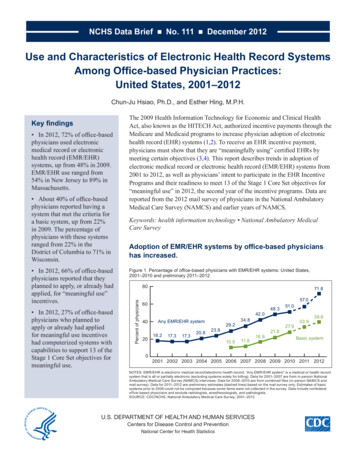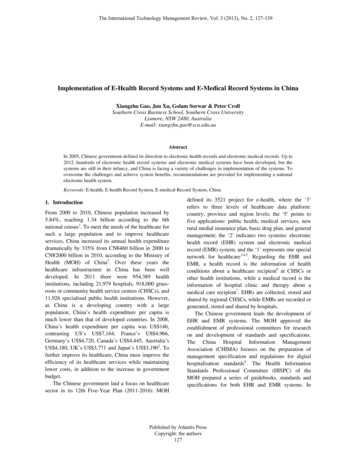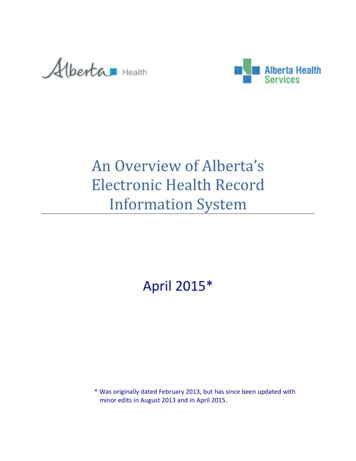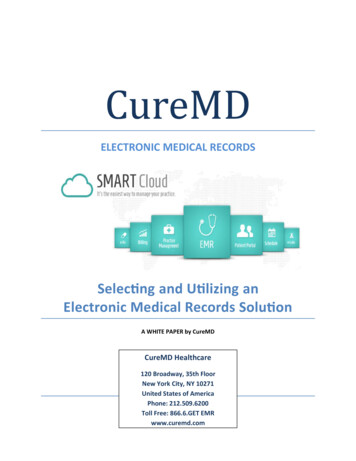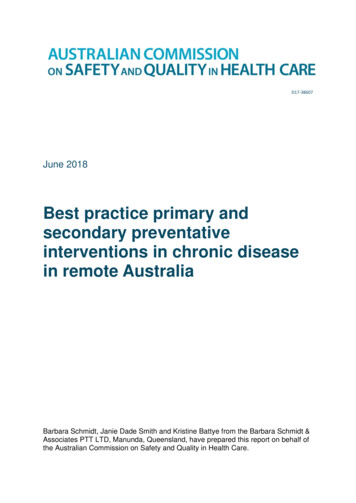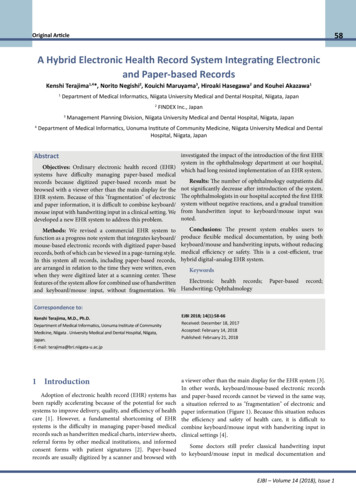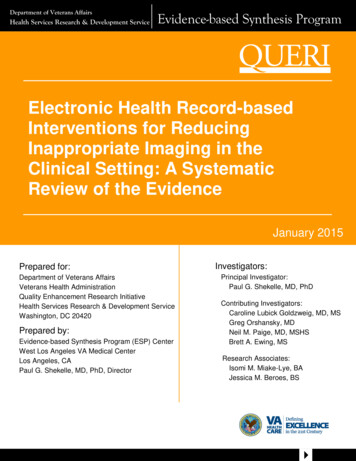
Transcription
Department of Veterans AffairsHealth Services Research & Development ServiceEvidence-based Synthesis ProgramElectronic Health Record-basedInterventions for ReducingInappropriate Imaging in theClinical Setting: A SystematicReview of the EvidenceJanuary 2015Prepared for:Department of Veterans AffairsVeterans Health AdministrationQuality Enhancement Research InitiativeHealth Services Research & Development ServiceWashington, DC 20420Prepared by:Evidence-based Synthesis Program (ESP) CenterWest Los Angeles VA Medical CenterLos Angeles, CAPaul G. Shekelle, MD, PhD, DirectorInvestigators:Principal Investigator:Paul G. Shekelle, MD, PhDContributing Investigators:Caroline Lubick Goldzweig, MD, MSGreg Orshansky, MDNeil M. Paige, MD, MSHSBrett A. Ewing, MSResearch Associates:Isomi M. Miake-Lye, BAJessica M. Beroes, BS
EHR Interventions for Reducing Inappropriate ImagingEvidence-based Synthesis ProgramPREFACEQuality Enhancement Research Initiative’s (QUERI) Evidence-based Synthesis Program (ESP)was established to provide timely and accurate syntheses of targeted healthcare topics ofparticular importance to Veterans Affairs (VA) clinicians, managers and policymakers as theywork to improve the health and healthcare of Veterans. The ESP disseminates these reportsthroughout the VA, and some evidence syntheses inform the clinical guidelines of largeprofessional organizations.QUERI provides funding for four ESP Centers and each Center has an active universityaffiliation. The ESP Centers generate evidence syntheses on important clinical practice topics,and these reports help: develop clinical policies informed by evidence;guide the implementation of effective services to improve patientoutcomes and to support VA clinical practice guidelines and performancemeasures; andset the direction for future research to address gaps in clinical knowledge.In 2009, the ESP Coordinating Center was created to expand the capacity of HSR&D CentralOffice and the four ESP sites by developing and maintaining program processes. In addition, theCenter established a Steering Committee comprised of QUERI field-based investigators, VAPatient Care Services, Office of Quality and Performance, and Veterans Integrated ServiceNetworks (VISN) Clinical Management Officers. The Steering Committee provides programoversight, guides strategic planning, coordinates dissemination activities, and developscollaborations with VA leadership to identify new ESP topics of importance to Veterans and theVA healthcare system.Comments on this evidence report are welcome and can be sent to Nicole Floyd, ESPCoordinating Center Program Manager, at Nicole.Floyd@va.gov.Recommended citation: Goldzweig C L, Orshansky G, Paige N M, Ewing B A, Miake-Lye I M,Beroes J M, Shekelle P G. Electronic Health Record-Based Interventions for ReducingInappropriate Imaging in the Clinical Setting: A Systematic Review of the Evidence. VA ESPProject #05-226; 2014.This report is based on research conducted by the Evidence-based Synthesis Program (ESP) Centerlocated at the West Los Angeles VA Medical Center, Los Angeles, CA, funded by the Department ofVeterans Affairs, Veterans Health Administration, Office of Research and Development, QualityEnhancement Research Initiative. The findings and conclusions in this document are those of theauthor(s) who are responsible for its contents; the findings and conclusions do not necessarily representthe views of the Department of Veterans Affairs or the United States government. Therefore, nostatement in this article should be construed as an official position of the Department of Veterans Affairs.No investigators have any affiliations or financial involvement (eg, employment, consultancies, honoraria,stock ownership or options, expert testimony, grants or patents received or pending, or royalties) thatconflict with material presented in the report. i
EHR Interventions for Reducing Inappropriate ImagingEvidence-based Synthesis ProgramTABLE OF CONTENTSPreface . iEXECUTIVE SUMMARYIntroduction.1Methods .1Data Sources and Searches .1Study Selection.1Data Abstraction and Quality Assessment.2Data Synthesis and Analysis .2Results .2Results of Literature Search .2Summary of Results for Key Question 1 and 2 .3Summary of Results for Key Question 3 .4Discussion .4Key Findings and Quality of Evidence.4Applicability.5Research Gaps/Future Research .5Conclusions .5EVIDENCE REPORTIntroduction .7Methods .8Topic Development .8Search Strategy .8Study Selection .9Data Abstraction .10Quality Assessment .10Data Synthesis .11Rating the Body of Evidence .11Peer Review .12Results .13Literature Flow.13 ii
EHR Interventions for Reducing Inappropriate ImagingEvidence-based Synthesis ProgramKey Question 1: What is the effectiveness of EHR-based interventions in reducingunnecessary or inappropriate imaging? .18Key Question 2: Do EHR-based interventions vary in results by system? .18Effect of Intervention Characteristics, Setting, Implementation, and Targeton Effectiveness .21VA Studies .26Summary of Findings and Quality of Evidence for Key Question 1 and 2 .26Key Question 3: What are the harms or potential harms associated with EHR-basedinterventions used to reduce inappropriate imaging?.27Summary of Findings .27Quality of Evidence for Key Question 3 .27Summary and Discussion .28Summary of Evidence by Key Question .28Key Question 1: What is the effectiveness of EHR-based interventions in reducingunnecessary or inappropriate imaging? .28Key Question 2: Do EHR-based interventions vary in results by system? .28Key Question 3 .28Limitations .28Publication Bias.28Study Quality .28Heterogeneity .29Applicability of Findings to the VA Population .29Research Gaps/Future Research .29Conclusions .29References .30APPENDICESAppendix A. Evidence Tables .34Appendix B. Search Strategies .46Appendix C. Description of Outcomes Used as Measures of Appropriate or Inappropriate Use . 49Appendix D. Data Abstraction .50Appendix E. Peer Review Comments/Author Responses .51 iii
EHR Interventions for Reducing Inappropriate ImagingEvidence-based Synthesis ProgramTABLESAbbreviations Table .6Table 1. Criteria Used to Assess the Quality of Included Studies . 10Table 2. Articles with Type of Outcome Presented . 15FIGURESFigure 1. Literature Flow Chart . 13Figure 2. Studies Reporting Both Appropriateness and Utilization Outcomes . 17Figure 3. Results for Appropriateness from Individual Studies . 19Figure 4. Results for Utilization from Individual Studies . 21Figure 5. Appropriateness Results Stratified by Intervention Characteristics and by Setting . 23Figure 6. Appropriateness Results Stratified by Implementation Characteristics and by Target . 25 iv
EHR Interventions for Reducing Inappropriate ImagingEvidence-based Synthesis ProgramEXECUTIVE SUMMARYINTRODUCTIONThere are widespread concerns within Veterans Affairs (VA) healthcare and in non-VA UShealthcare that the costs of healthcare are rising at unsustainable rates. One driver of cost is theincreasing use of radiology imaging procedures, particularly advanced imaging techniques suchas computed tomography (CT) scanning, magnetic resonance imaging (MRI), and CTangiography. Most authorities agree that more appropriate use of certain imaging tests could bothimprove quality and save costs.The recognition that more appropriate use of imaging could improve quality and reduce costs hasled to the development of interventions to encourage more appropriate radiology utilization.Some of these interventions have made use of the clinical decision support capabilities ofelectronic health records (EHR). VA has been a leader in the use of electronic health records andclinical decision support.In recognition of the risks and costs associated with inappropriate imaging, VA leadership hasrequested an evidence synthesis which evaluates studied methods for reducing inappropriateimaging that center around the electronic health record (EHR). The final key questions are:Key Question 1: What is the effectiveness of EHR-based interventions in reducing unnecessaryor inappropriate imaging?Key Question 2: Do EHR-based interventions vary in results by system (type of EHRintervention)?Key Question 3: What are the harms or potential harms associated with EHR-based interventionsused to reduce inappropriate imaging?METHODSData Sources and SearchesWe searched the references of existing broad based health information technology (IT)systematic reviews covering the period 1995-2011, and also performed a search of PubMed andWeb of Science from 2011 to 9/10/2014 using terms including “Medical InformaticsApplications[Mesh],” “Decision Support Systems, Clinical[Mesh],” “medical records systems,computerized,” “health information technolog*,” “electronic medical record*,” and “radiologydepartment.”Study SelectionParticipants: Adult population. Studies aimed only at children were excluded. Studies with mixedpopulations were included.Intervention: EHR-based interventions for reducing imaging for diagnostic purposes (as opposedto screening) considered inappropriate or unnecessary based on clinical guidelines. This meantthat studies seeking to increase the use of radiographic imaging like mammography for breast 1
EHR Interventions for Reducing Inappropriate ImagingEvidence-based Synthesis Programcancer screening were excluded. Studies of systems running on personal digital assistants wereexcluded. Studies of web-based interventions or computerized, stand-alone systems that wejudged could be easily incorporated into the EHR were included.Comparator (study design): Usual care.Outcome: Rates of imaging procedures judged as unnecessary based on existing clinicalguidelines. Studies that reported on changes in appropriateness (as opposed to decrease inappropriateness) were also included. Studies that targeted the use of imaging procedures stated asbeing overused and then reporting only utilization data were included. Utilization outcomes wereconsidered separate from appropriateness outcomes. A table of all outcomes included as“appropriateness” is in Appendix C.Timing: All timesSetting: Ambulatory, hospital, and emergency department settings.Data Abstraction and Quality AssessmentData were extracted by 2 reviewers, and discrepancies were reconciled with the group. Articleshad data abstracted on study design, time period, setting, imaging modality, intervention,comparison, sample size, target of intervention, findings, IT design, data entry for intervention,and implementation characteristics. We assessed the quality of studies by their design and thedegree to which they reported information about intervention and implementation characteristics.Data Synthesis and AnalysisWe used as the primary outcome the effect of the intervention on the appropriateness outcome.This could have been the increase in appropriate use or the decrease in inappropriate use; studiesrarely reported both. As a secondary outcome, we used the effect on utilization. Random effectsmeta-analyses were conducted using the H-K variance estimator. After collecting data on theinterventions, implementations, and settings, but prior to extraction of outcomes data, wedeveloped 4 hypotheses regarding effectiveness of the intervention, one in each category ofintervention characteristics, settings, implementation, and target.RESULTSResults of Literature SearchFrom all sources, we retrieved 1,195 titles. From these, we identified 172 titles as beingpotentially relevant. After reviewing these 172 abstracts, we identified 105 titles for full textreview. Of these, we rejected a total of 82 articles, with 10 rejected for their study design (eg, acommentary, editorial, review, etc), 27 rejected as being about radiology imaging for screening,one rejected for being in a child-aged population, and 39 rejected as not being EHR-based or notabout clinical decision support (CDS) or not about imaging.Of the 23 articles included, 3 were randomized trials, 7 were time series studies, and 13 werepre-post studies. Seven studies collected data prior to the year 2000, 7 studies included datacollection within the past 5 years (2009 or later). Ten interventions targeted what was sometimescalled “high cost imaging,” which usually included CT and MRI and occasionally nuclear 2
EHR Interventions for Reducing Inappropriate ImagingEvidence-based Synthesis Programmedicine tests as well. Four interventions targeted pulmonary CT angiography, 2 studies targetedchest x-ray, 4 interventions targeted multiple radiologic investigations, and 3 studies had otherradiologic targets.In 5 studies, the intervention consisted of simply the display of information, such as the cost oftests, relevant guidelines, or an appropriateness rating for the requested radiology examinationfor that indication. Nine studies displayed patient-specific information about whether or not therequested study was consistent with existing guidelines (or something similar). Four studiesincluded what we characterized as a “soft stop,” meaning for radiology orders that the CDS ratedas inconsistent with guidelines or inappropriate, the provider needed to enter a reason why theCDS advice was being over-ridden. Five studies included a “hard stop,” meaning providers wereprevented from ordering radiology examinations the CDS classified as inappropriate withoutgetting approval from some external person, usually a radiologist or senior clinician.Two studies did not present data sufficient to include in our quantitative analysis, one because itdid not present comparative data without the intervention and one because the outcome was anaggregate measure of many tests, and data specific to the radiology targets were not presented.Of the remaining 21 studies, 13 reported an appropriateness outcome and 13 reported autilization outcome; 5 studies reported both.Summary of Results for Key Question 1 and 2Thirteen studies contributed to each pooled analysis, one pooled analysis for appropriateness andone pooled analysis for utilization. Four studies contributed data to both. Our primary outcomewas the effect on appropriateness. Nine of the 13 studies reported statistically significant benefitsof the intervention, 2 reported a benefit that was not statistically significant, and 2 studiesreported no effect. The random effects pooled estimate from all 13 studies was an effect size of0.48 (95% CI: -0.71, -0.25). This equates to a “moderate” sized effect, according to aconventional classification.Thirteen studies reported utilization outcomes. Six studies reported statistically significantbenefits of the intervention, and 7 studies reported essentially no effect. The random effectspooled estimate from all 13 studies was an effect size of 0.13 (95% CI: -0.23, -0.04). Thisequates to a “small” sized effect, according to a conventional classification.We explored 4 hypotheses regarding effectiveness, one each for characteristics of theintervention, the setting (integrated care delivery versus other settings), the implementationprocess (the use of audit and feedback was the only implementation characteristic with sufficientdata to support a stratified analysis), and the radiologic target of the intervention. We hadinsufficient studies to support robust pooled estimates of individual strata or to supportmultivariable analyses. Nevertheless, some patterns are apparent.All of the interventions with a “hard stop” reported moderate-to-large effects on appropriateness.Studies using other interventions reported more variable effects or had insufficient numbers todraw conclusions.The 3 studies conducted in integrated care settings all reported large effects on appropriatenessand small-to-moderate effects on utilization. Studies conducted at the US institutions that are 3
EHR Interventions for Reducing Inappropriate ImagingEvidence-based Synthesis Programleaders in health IT, and other settings, produced more mixed results, although all 5 of the 6studies of appropriateness at the health IT leaders reported statistically significant benefits of theintervention.There were too few studies using audit-and-feedback to draw conclusions and no apparentpattern in studies of interventions at different radiology targets.Summary of Results for Key Question 3Four studies reported on harms associated with their interventions. One study, evaluating adecision support tool to reduce unnecessary pre-operative testing, found that with theintervention there was an increase in the percent of pre-operative chest x-rays inappropriately notordered. Prior to the intervention 1.9% of patients did not get a chest x-ray when indicated,compared to 9.3% after the intervention. The clinical impact of this is not known. Another studyof a decision support tool to reduce abdominal kidney, ureter, bladder (KUB) x-rays identified 12KUB studies out of a total of 255 performed against the advice of the tool where there werepositive findings. Of these 12, six KUB studies were felt to have significantly influenced patientoutcomes, making it unclear whether following the locally developed guidance could haveendangered the patient. The 2 other studies reported on qualitative information from physiciansurveys which primarily identified lack of interest in using the decision support tools because oftime constraints and perceived inefficiencies.DISCUSSIONKey Findings and Quality of EvidenceKey Question 1 and 2Summary of Findings and Quality of EvidenceTwenty-one studies provide moderate-quality evidence that EHR-based interventions can reduceinappropriate test ordering by a moderate amount, and reduce overall utilization by a smallamount. Low-quality evidence supports that interventions that include a “hard stop,” preventingordering clinicians from overriding a decision support determination that a test is inappropriate,and implementation in an integrated care delivery setting, are associated with greatereffectiveness. Audit-and-feedback may be a useful implementation tool, but data are too sparseto draw conclusions. We judged the quality of evidence regarding appropriateness and utilizationas moderate, due to heterogeneity in the results. We judged the quality of evidence regarding thecharacteristics as low, due to the sparseness of the data and indirect nature of the comparisonsThat is, these characteristics have not been tested as a priori hypotheses for differentialeffectiveness within the same study.Key Question 3Summary of FindingsThere are few data on the potential harms of decision support tools to reduce inappropriateradiology test ordering. Future studies should evaluate for harms – particularly investigatingwhether guidelines when applied in practice provide unanticipated results, or when there areissues related to workflow, efficiency, or provider dissatisfaction that could impact a decision 4
EHR Interventions for Reducing Inappropriate ImagingEvidence-based Synthesis Programsupport tool’s effectiveness. For example, in a study of CDS to prevent drug-drug interactions,the use of a “hard stop” intervention – while effective in changing prescribing – resulted indelays in treatment for 4 patients, resulting in preventative stopping of the study by theInstitutional Review Board.1 Another study, excluded from our review because it assessed apediatric population, surveyed physicians and found that most felt the CDS was “a nuisance” and“not relevant to the complex or high risk patients they had to treat.”2 This highlights the need forassessment of harms and unintended effects in every evaluation.Quality of EvidenceWe judged the quality of evidence for harms as very low, meaning any estimate is uncertain.ApplicabilityOnly 3 studies were performed in integrated care delivery settings, and only one study wasperformed in the VA. However, there is evidence suggesting that interventions implemented inintegrated care delivery settings may be more effective than in other settings, indicating VA mayrealize benefits equal to or greater than the average benefit reported here.Research Gaps/Future ResearchWe identified the following research gaps:Direct comparisons are needed of different intervention characteristics. We found suggestiveevidence that interventions with a “hard stop” are more effective than other interventions, but toprove this hypothesis requires testing the 2 methods head-to-head in the same study. This shouldbe easy to do, since randomization can occur at the provider level, and consist of the CDS withand without the hard stop.More research is needed on possible harms. Harms of a CDS system intervention with a “hardstop” have been reported in other clinical situations. An explicit assessment of harms should beincorporated into every study of interventions.About half of our included studies collected data more than 7 years ago, and informationtechnology and attitudes about the use of information technology change over time, so data frommore recent time periods would be helpful.One study reported differential effectiveness by target, and this should be assessed in futurestudies.Like all health IT evaluations, more information about context and implementation is needed.ConclusionsComputerized decision support integrated with the electronic health record can reduceinappropriate use of diagnostic radiology testing by a moderate amount. The use of a “hard stop”as part of the intervention, the use of audit-and-feedback as part of the implementation, and usein an integrated care delivery setting may all increase effectiveness. There are few data on thepotential harms of decision support tools to reduce inappropriate radiology test ordering. Futurestudies should evaluate for harms. 5
EHR Interventions for Reducing Inappropriate ImagingEvidence-based Synthesis ProgramAbbreviations TableCDSclinical decision supportCTcomputed tomographyMRImagnetic resonance imagingEHRelectronic health recordITinformation technologyKUBkidney, ureter, bladderEDemergency departmentRCTrandomized controlled trialCPOEcomputerized physician order entryGRADEGrading of Recommendations Assessment, Development and EvaluationUGIupper gastrointestinalVQventilation/perfusion lung scanCXRchest x-rayGIgastrointestinalPOEphysician order entryPEpulmonary embolismAXRabdominal und (only when used in evidence tables)EKGelectrocardiogram 6
EHR Interventions for Reducing Inappropriate ImagingEvidence-based Synthesis ProgramEVIDENCE REPORTINTRODUCTIONThere are widespread concerns within Veterans Affairs (VA) healthcare and in non-VA UShealthcare that the costs of healthcare are rising at unsustainable rates. One driver of cost is theincreasing use of radiology imaging procedures, particularly advanced imaging techniques suchas computed tomography (CT) scanning, magnetic resonance imaging (MRI), and CTangiography. Advances in imaging capabilities allow physicians to image ever-finer areas withinthe body, and the ease with which many of these tests are ordered has led to dramatic increasesin the rates of use of many tests. For example, the use of CT scans in the Emergency Department(ED) grew by 330% in the 12 years from 1996 through 2007, at a time when the rate of ED visitsgrew by only 11%.3 Similarly, other investigators reported a 3-fold increase in the likelihood ofgetting a CT scan or MRI during an ED visit between 1998 and 2007.4These dramatic increases in utilization have led to increased scrutiny regarding the clinical valueof these imaging studies. In some cases, strong evidence exists that the imaging studies provideno value, or even harm patients. For example, a meta-analysis of early lumbar imaging forpatients with acute low back pain included 5 randomized controlled trials (RCTs) where patientswere randomized to receive or not receive early imaging in the form of a plain film, a CT, or anMRI. At 3 months, there was no improvement in pain or function among patients who hadreceived imaging.5 In other cases, strong professional opinion considers certain tests to be oflittle value, mainly because alternate tests are preferred or the probability of an abnormal imageis exceedingly remote.There is widespread agreement that more appropriate use of certain imaging test
imaging that center around the electronic health record (EHR). The final key questions are: Key Question 1: What is the effectiveness of EHR-based interventions in reducing unnecessary or inappropriate imaging? Key Question 2: Do EHR-based interventions vary in results by system (type of EHR intervention)?
